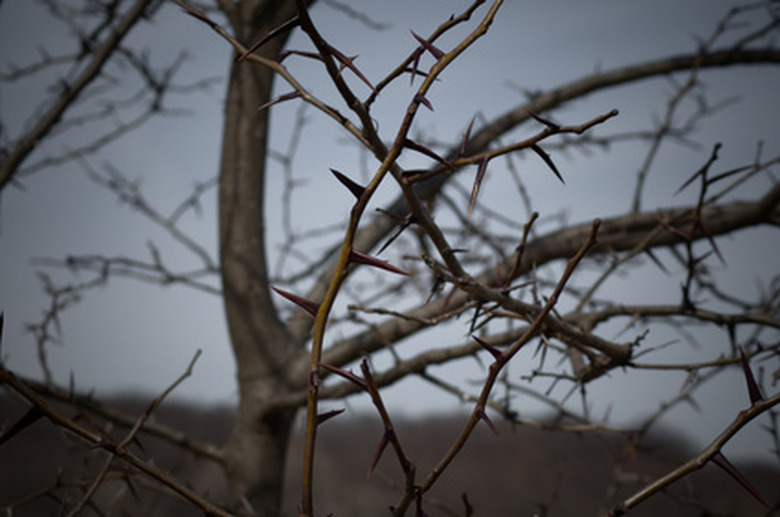What Plants Grow In The Kalahari Desert?
The arid and semi-arid Kalahari Desert, about four times the size of great Britain, stretches over most of Botswana and parts of Namibia and South Africa. Winter temperatures can drop to freezing, and summer temperatures can rise to 104 degrees Fahrenheit. Among the many plants species that have evolved to survive these environmental extremes, only a handful are widespread or have special uses.
Camel Thorn Tree
Under the harshest conditions of the Kalahari, the Camel Thorn Tree, Acacia erioloba, is actually a shrub, but under the right conditions it can grow into a tree up to 30 feet high. Its Afrikaans name, "Kameeldoringboom," does not come from the Dromedary camel, which is imported into the Kalahari, but from Camelopardus, the Latin name for the giraffe, Kaleemperd in Afrikaans.
The plant's crescent-shaped seed pods, covered by a fine gray down and said to resemble camel hair, are from 4 to 5 inches from end to end. A mature tree can produce more than a thousand pounds of these pods in a year, each of which contains several hard, shiny seeds that are part of the survival rations for Bushmen.
- The arid and semi-arid Kalahari Desert, about four times the size of great Britain, stretches over most of Botswana and parts of Namibia and South Africa.
- Under the harshest conditions of the Kalahari, the Camel Thorn Tree, Acacia erioloba, is actually a shrub, but under the right conditions it can grow into a tree up to 30 feet high.
The hard, dense wood of the camel thorn tree is prized for "braaivleis," Afrikaans for barbecue. It is protected by the South African government, and a permit is needed to cut it.
Shepherd's Tree
The Shepherd's Tree, Boscia albitrunca, with white bark and small, dark green leaves, is one of the few trees that will grow on the slopes of a sand dune. It yields berries that are eaten raw, made into jam or combined with yogurt. Its roots are used to make a coffee substitute and boiled to make a sweet syrup. They are also ground and used as a flour.
Gray Camel Thorn Tree
The Gray Camel Thorn, Acacia Itaematoxylon, has gray foliage. It usually grows as a multi-stemmed shrub, although it can grow into a tree in sand flats and dry river beds. The seedpods are thinner and more round than the true Camel Thorn, and there are indentations between the seeds, making the pod look like a string of beads.
- The hard, dense wood of the camel thorn tree is prized for "braaivleis," Afrikaans for barbecue.
- The Shepherd's Tree, Boscia albitrunca, with white bark and small, dark green leaves, is one of the few trees that will grow on the slopes of a sand dune.
Tsmamma or Kalahari Desert Melon
A relative of the cultivated watermelon, the Tsamma, Citrulus lanatus, can remain firm and fresh for more than two years. Both animals and Bushmen eat it for the water in its juice, which tastes better if it is cooked. The juice ferments after two days. An oil from its seeds is highly prized.
Ghaap
Ghaap (pronounce Garp), Hoodia gordonii, has became famous because it contains an active ingredient that acts as a diet suppressant. Although those properties were discovered by the San Bushmen and the Ghaap is found in the Kalahari, it is more frequently found in Bushmanland and Namaqualand in the Ghaap Plateau. There are bitter and sweet varieties of Ghaap. It is a succulent, not a cactus, as is popularly believed and frequently misidentified.
- A relative of the cultivated watermelon, the Tsamma, Citrulus lanatus, can remain firm and fresh for more than two years.
- Both animals and Bushmen eat it for the water in its juice, which tastes better if it is cooked.
